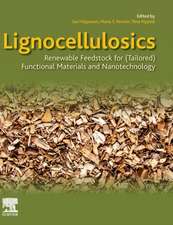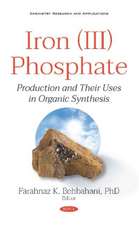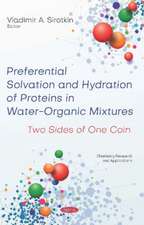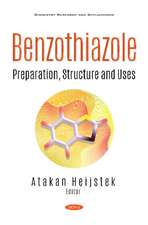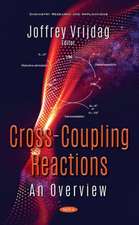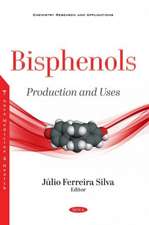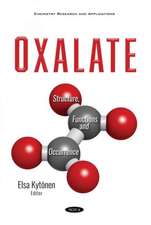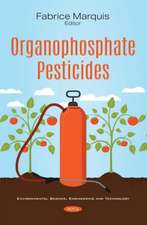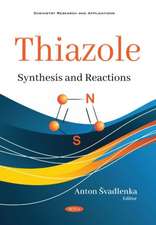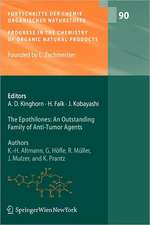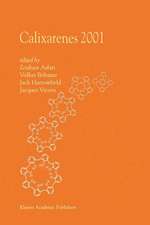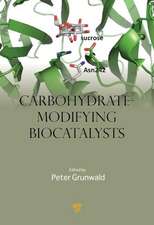Modern Physical Organic Chemistry
Autor Eric V. Anslyn, Dennis A. Doughertyen Limba Engleză Hardback – 31 iul 2005
Preț: 716.58 lei
Preț vechi: 833.24 lei
-14% Nou
Puncte Express: 1075
Preț estimativ în valută:
137.11€ • 143.55$ • 113.46£
137.11€ • 143.55$ • 113.46£
Carte disponibilă
Livrare economică 17-31 martie
Livrare express 28 februarie-06 martie pentru 99.95 lei
Preluare comenzi: 021 569.72.76
Specificații
ISBN-13: 9781891389313
ISBN-10: 1891389319
Pagini: 1300
Ilustrații: 387 illustrations
Dimensiuni: 225 x 298 x 46 mm
Greutate: 2.59 kg
Editura: MACMILLAN EDUCATION
Locul publicării:Sausalito, United States
ISBN-10: 1891389319
Pagini: 1300
Ilustrații: 387 illustrations
Dimensiuni: 225 x 298 x 46 mm
Greutate: 2.59 kg
Editura: MACMILLAN EDUCATION
Locul publicării:Sausalito, United States
Cuprins
Introduction to Structure and Models of Bonding
Strain and Stability
The Thermodynamics of Solutions and Noncovalent Binding Forces
Molecular Recognition and Supramolecular Chemistry
Acid-Base Chemistry
Stereochemistry
Energy Surfaces and Kinetic Analyses
Experiments Related to Thermodynamics and Kinetics
Catalysis
Organic Reaction Mechanisms Part 1: Reactions Involving Additions and/or Eliminations
Organic Reaction Mechanisms Part II: Substitutions at Aliphatic Centers and Thermal Isomerizations/Rearrangements
Organotransition Metal Reaction Mechanisms and Catalysis
Organic Materials Chemistry
Advanced Concepts in Electronic Structure Theory
Thermal Pericyclic Reactions
Photochemistry
Electronic Organic Materials
Strain and Stability
The Thermodynamics of Solutions and Noncovalent Binding Forces
Molecular Recognition and Supramolecular Chemistry
Acid-Base Chemistry
Stereochemistry
Energy Surfaces and Kinetic Analyses
Experiments Related to Thermodynamics and Kinetics
Catalysis
Organic Reaction Mechanisms Part 1: Reactions Involving Additions and/or Eliminations
Organic Reaction Mechanisms Part II: Substitutions at Aliphatic Centers and Thermal Isomerizations/Rearrangements
Organotransition Metal Reaction Mechanisms and Catalysis
Organic Materials Chemistry
Advanced Concepts in Electronic Structure Theory
Thermal Pericyclic Reactions
Photochemistry
Electronic Organic Materials
Recenzii
'A most impressive resource for researchers and teachers, and yet it also offers an accessible entrée into the topics for advanced undergraduates and postgraduates... well structured and very pleasant to read... a book I am very happy to have on my shelf.' - The Times Higher Education Supplement
Notă biografică
ERIC V. ANSLYN, Professor, University of Texas, USA.
DENNIS A. DOUGHERTY George Grant Hoag Professor of Chemistry, California Institute of Technology, USA.
DENNIS A. DOUGHERTY George Grant Hoag Professor of Chemistry, California Institute of Technology, USA.
Caracteristici
1 Landmark text to update the field by two prominent researchers
2 Inclusive of organometallic, materials, and biological chemistry
3 Can serve as a text for a year-long course, as well as for a variety of shorter courses on selected aspects of the field
4 Invaluable reference tool and introduction to many of the more advanced topics of interest to modern researchers
2 Inclusive of organometallic, materials, and biological chemistry
3 Can serve as a text for a year-long course, as well as for a variety of shorter courses on selected aspects of the field
4 Invaluable reference tool and introduction to many of the more advanced topics of interest to modern researchers
Descriere
This modern textbook makes explicit the many connections between physical organic chemistry and critical fields such as organometallic chemistry, materials chemistry, bioorganic chemistry, and biochemistry. In the latter part of the twentieth century, the field of physical organic chemistry went through dramatic changes, with an increased emphasis on noncovalent interactions and their roles in molecular recognition, supramolecular chemistry, and biology; the development of new materials with novel structural features; and the use of computational methods. Contemporary chemists must be just as familiar with these newer fields as with the more established classical topics.
Modern Physical Organic Chemistry is intended to bridge that gap. In addition to covering thoroughly the core areas of physical organic chemistry - structure and mechanism - the book will escort the practitioner of organic chemistry into a field that has been thoroughly updated. The foundations and applicabilities of modern computational methods are also developed.
Modern Physical Organic Chemistry is intended to bridge that gap. In addition to covering thoroughly the core areas of physical organic chemistry - structure and mechanism - the book will escort the practitioner of organic chemistry into a field that has been thoroughly updated. The foundations and applicabilities of modern computational methods are also developed.

